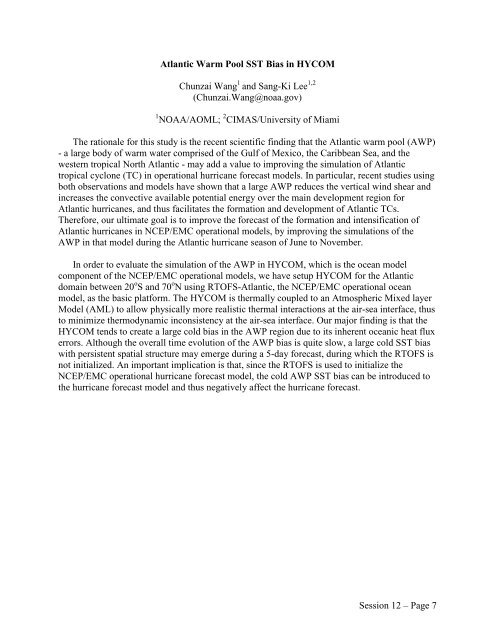65th IHC Booklet/Program (pdf - 4.9MB) - Office of the Federal ...
65th IHC Booklet/Program (pdf - 4.9MB) - Office of the Federal ...
65th IHC Booklet/Program (pdf - 4.9MB) - Office of the Federal ...
You also want an ePaper? Increase the reach of your titles
YUMPU automatically turns print PDFs into web optimized ePapers that Google loves.
Atlantic Warm Pool SST Bias in HYCOM<br />
Chunzai Wang 1 and Sang-Ki Lee 1,2<br />
(Chunzai.Wang@noaa.gov)<br />
1 NOAA/AOML; 2 CIMAS/University <strong>of</strong> Miami<br />
The rationale for this study is <strong>the</strong> recent scientific finding that <strong>the</strong> Atlantic warm pool (AWP)<br />
- a large body <strong>of</strong> warm water comprised <strong>of</strong> <strong>the</strong> Gulf <strong>of</strong> Mexico, <strong>the</strong> Caribbean Sea, and <strong>the</strong><br />
western tropical North Atlantic - may add a value to improving <strong>the</strong> simulation <strong>of</strong> Atlantic<br />
tropical cyclone (TC) in operational hurricane forecast models. In particular, recent studies using<br />
both observations and models have shown that a large AWP reduces <strong>the</strong> vertical wind shear and<br />
increases <strong>the</strong> convective available potential energy over <strong>the</strong> main development region for<br />
Atlantic hurricanes, and thus facilitates <strong>the</strong> formation and development <strong>of</strong> Atlantic TCs.<br />
Therefore, our ultimate goal is to improve <strong>the</strong> forecast <strong>of</strong> <strong>the</strong> formation and intensification <strong>of</strong><br />
Atlantic hurricanes in NCEP/EMC operational models, by improving <strong>the</strong> simulations <strong>of</strong> <strong>the</strong><br />
AWP in that model during <strong>the</strong> Atlantic hurricane season <strong>of</strong> June to November.<br />
In order to evaluate <strong>the</strong> simulation <strong>of</strong> <strong>the</strong> AWP in HYCOM, which is <strong>the</strong> ocean model<br />
component <strong>of</strong> <strong>the</strong> NCEP/EMC operational models, we have setup HYCOM for <strong>the</strong> Atlantic<br />
domain between 20 o S and 70 o N using RTOFS-Atlantic, <strong>the</strong> NCEP/EMC operational ocean<br />
model, as <strong>the</strong> basic platform. The HYCOM is <strong>the</strong>rmally coupled to an Atmospheric Mixed layer<br />
Model (AML) to allow physically more realistic <strong>the</strong>rmal interactions at <strong>the</strong> air-sea interface, thus<br />
to minimize <strong>the</strong>rmodynamic inconsistency at <strong>the</strong> air-sea interface. Our major finding is that <strong>the</strong><br />
HYCOM tends to create a large cold bias in <strong>the</strong> AWP region due to its inherent oceanic heat flux<br />
errors. Although <strong>the</strong> overall time evolution <strong>of</strong> <strong>the</strong> AWP bias is quite slow, a large cold SST bias<br />
with persistent spatial structure may emerge during a 5-day forecast, during which <strong>the</strong> RTOFS is<br />
not initialized. An important implication is that, since <strong>the</strong> RTOFS is used to initialize <strong>the</strong><br />
NCEP/EMC operational hurricane forecast model, <strong>the</strong> cold AWP SST bias can be introduced to<br />
<strong>the</strong> hurricane forecast model and thus negatively affect <strong>the</strong> hurricane forecast.<br />
Session 12 – Page 7
















